Identifying Dopamine D3 Receptor Ligands through Virtual Screening and Exploring the Binding Modes of Hit Compounds
Abstract
:1. Introduction
2. Results and Discussion
2.1. Virtual Screening
2.1.1. Receptor Selection and Preparation
2.1.2. Validation of the Docking Method
2.1.3. Virtual Screening via AutoDock Vina Docking and Compounds Selection
2.2. D3R Binding-Affinity Assays
2.3. Exploring the D3R-Binding Modes of the Hit Compounds
2.3.1. Analyzing the AutoDock Vina-Based Docking Poses of the Hit Compounds
2.3.2. Methods for Inferring the Binding Modes of Protein–Ligand Complexes Using Computational Methods
2.3.3. Validating the AutoDock Vina Docking Poses
2.3.4. Exploring Potential Binding Poses Using a Combination of IFD and BPMD Simulations
2.3.5. MD Analysis of BPMD-Output Poses
3. Methods and Materials
3.1. Structure-Based Virtual Screening
3.1.1. Hardware, Software, and Online Resources
3.1.2. Receptor and Ligand Preparation
3.1.3. Validation of the Docking Method
3.1.4. Virtual Screening with AutoDock Vina and Compound Selection
3.2. Biochemical Assays
3.2.1. Materials
3.2.2. CHO–hDRD3 Cell Membrane Preparation
3.2.3. [3H]-Spiperone-Filtration Binding Assay on Membranes from CHO–hDRD3 Cells
3.3. Exploring the D3R-Binding Modes of Hit Compounds via Induced-Fit Docking (IFD), Binding Pose Metadynamics Simulation, Unbiased Molecular Dynamics (MD) Simulation, and Molecular Mechanics Generalized Born-Surface Area (MM/GBSA) Analysis
3.3.1. IFD Analysis to Determine Potential Ligand-Binding Poses with D3R
3.3.2. Chemoinformatics: Structural-Interaction Fingerprints
3.3.3. BPMD Simulations
3.3.4. Unbiased MD Simulations
3.3.5. Interactions Analysis, Trajectory Clustering, and MM/GBSA Calculations
4. Conclusions
Supplementary Materials
Author Contributions
Funding
Institutional Review Board Statement
Informed Consent Statement
Data Availability Statement
Acknowledgments
Conflicts of Interest
Sample Availability
References
- Martel, J.; McArthur, S.G. Dopamine Receptor Subtypes, Physiology and Pharmacology: New Ligands and Concepts in Schizophrenia. Front. Pharmacol. 2020, 11, 1003. [Google Scholar] [CrossRef] [PubMed]
- Carlsson, A. The current status of the dopamine hypothesis of schizophrenia. Neuropsychopharmacol. Off. Publ. Am. Coll. Neuropsychopharmacol. 1988, 1, 179–186. [Google Scholar] [CrossRef]
- Galaj, E.; Newman, A.; Xi, Z. Dopamine D3 receptor-based medication development for the treatment of opioid use disorder: Rationale, progress, and challenges. Neurosci. Biobehav. Rev. 2020, 114, 38–52. [Google Scholar] [CrossRef] [PubMed]
- Dooley, M.; Markham, A.; Pramipexole. A review of its use in the management of early and advanced Parkinson’s disease. Drugs Aging 1998, 12, 495–514. [Google Scholar] [CrossRef] [PubMed]
- Matheson, A.J.; Spencer, C.M. Ropinirole: A review of its use in the management of Parkinson’s disease. Drugs 2000, 60, 115. [Google Scholar] [CrossRef] [PubMed]
- Reynolds, N.A.; Wellington, K.; Easthope, S.E. Rotigotine: In parkinson’s disease. CNS Drugs 2005, 19, 973–981. [Google Scholar] [CrossRef]
- Kiss, B.; Laszlovszky, I.; Kramos, B.; Visegrady, A.; Bobok, A.; Levay, G.; Lendvai, B.; Roman, V. Neuronal Dopamine D3 Receptors: Translational Implications for Preclinical Research and CNS Disorders. Biomolecules 2021, 11, 104. [Google Scholar] [CrossRef]
- Garnock-Jones, K. Cariprazine: A Review in Schizophrenia. CNS Drugs 2017, 31, 513–525. [Google Scholar] [CrossRef]
- Bitter, I.; Lieberman, J.; Gaudoux, F.; Sokoloff, P.; Groc, M.; Chavda, R.; Delsol, C.; Barthe, L.; Brunner, V.; Fabre, C.; et al. Randomized, double-blind, placebo-controlled study of F17464, a preferential D3 antagonist, in the treatment of acute exacerbation of schizophrenia. Neuropsychopharmacology 2019, 44, 1917–1924. [Google Scholar] [CrossRef]
- Trott, O.; Olson, A. AutoDock Vina: Improving the speed and accuracy of docking with a new scoring function, efficient optimization, and multithreading. J. Comput. Chem. 2010, 31, 455–461. [Google Scholar] [CrossRef]
- Vass, M.; Schmidt, É.; Horti, F.; Keserű, G.M. Virtual fragment screening on GPCRs: A case study on dopamine D3 and histamine H4 receptors. Eur. J. Med. Chem. 2014, 77, 38–46. [Google Scholar] [CrossRef] [PubMed]
- Pettersen, E.; Goddard, T.; Huang, C.; Couch, G.; Greenblatt, D.; Meng, E.; Ferrin, T. UCSF Chimera—A visualization system for exploratory research and analysis. J. Comput. Chem. 2004, 25, 1605–1612. [Google Scholar] [CrossRef] [PubMed] [Green Version]
- Sandor, M.; Kiss, R.; Keseru, G.M. Virtual fragment docking by Glide: A validation study on 190 protein—Fragment complexes. J. Chem. Inf. Model. 2010, 50, 1165–1172. [Google Scholar] [CrossRef] [PubMed]
- Liu, K.; Kokubo, H. Exploring the Stability of Ligand Binding Modes to Proteins by Molecular Dynamics Simulations: A Cross-docking Study. J. Chem. Inf. Model. 2017, 57, 2514–2522. [Google Scholar] [CrossRef]
- Miller, E.; Murphy, R.; Sindhikara, D.; Borrelli, K.; Grisewood, M.; Ranalli, F.; Dixon, S.; Jerome, S.; Boyles, N.; Day, T.; et al. Reliable and Accurate Solution to the Induced Fit Docking Problem for Protein-Ligand Binding. J. Chem. Theory Comput. 2021, 17, 2630–2639. [Google Scholar] [CrossRef]
- Jones, G.; Willett, P.; Glen, R.C.; Leach, A.R.; Taylor, R. Development and validation of a genetic algorithm for flexible docking. J. Mol. Biol. 1997, 267, 727–748. [Google Scholar] [CrossRef] [Green Version]
- Studio, D. Discovery Studio 2.1; Accelrys: San Diego, CA, USA, 2008. [Google Scholar]
- Sherman, W.; Beard, H.; Farid, R. Use of an induced fit receptor structure in virtual screening. Chem. Biol. Drug Des. 2006, 67, 83–84. [Google Scholar] [CrossRef]
- Sherman, W.; Day, T.; Jacobson, M.P.; Friesner, R.A.; Farid, R. Novel procedure for modeling ligand/receptor induced fit effects. J. Med. Chem. 2006, 49, 534–553. [Google Scholar] [CrossRef]
- Clark, A.J.; Tiwary, P.; Borrelli, K.; Feng, S.; Miller, E.B.; Abel, R. Prediction of Protein-Ligand Binding Poses via a Combination of Induced Fit Docking and Metadynamics Simulations. J. Chem. Theory Comput. 2016, 12, 2990–2998. [Google Scholar] [CrossRef]
- Deng, Z.; Chuaqui, C.; Singh, J. Structural interaction fingerprint (SIFt): A novel method for analyzing three-dimensional protein− ligand binding interactions. J. Med. Chem. 2004, 47, 337–344. [Google Scholar] [CrossRef]
- Bowers, K.J.; Chow, E.; Xu, H.; Dror, R.O.; Shaw, D.E. Scalable Algorithms for Molecular Dynamics Simulations on Commodity Clusters. In Proceedings of the 2006 ACM/IEEE Conference on Supercomputing, Tampa, FL, USA, 11–17 November 2006. [Google Scholar]
- Shan, Y.; Kim, E.T.; Eastwood, M.P.; Dror, R.; Seeliger, M.A.; Shaw, D.E. How does a drug molecule find its target binding site? J. Am. Chem. Soc. 2011, 133, 9181–9183. [Google Scholar] [CrossRef] [PubMed] [Green Version]
- Barducci, A.; Bonomi, M.; Parrinello, M. Metadynamics, WIREs Computational Molecular. Science 2011, 1, 826–843. [Google Scholar]
- Schrödinger Release 2021-3: Glide; Schrödinger, LLC: New York, NY, USA, 2021.
- Delano, W.L. The PyMOL Molecular Graphics System; DeLano Scientific: San Carlos, CA, USA, 2002. [Google Scholar]
- National Center for Biotechnology Information. Bethesda: U.S. National Library of Medicine. Available online: http://www.ncbi.nlm.nih.gov (accessed on 1 May 2020).
- Chien, E.; Liu, W.; Zhao, Q.; Katritch, V.; Han, G.; Hanson, M.; Shi, L.; Newman, A.; Javitch, J.; Cherezov, V.; et al. Structure of the human dopamine D3 receptor in complex with a D2/D3 selective antagonist. Science 2010, 330, 1091–1095. [Google Scholar] [CrossRef] [PubMed] [Green Version]
- Morris, G.; Huey, R.; Lindstrom, W.; Sanner, M.; Belew, R.; Goodsell, D.; Olson, A. AutoDock4 and AutoDockTools4: Automated docking with selective receptor flexibility. J. Comput. Chem. 2009, 30, 2785–2791. [Google Scholar] [CrossRef] [Green Version]
- Forli, S.; Huey, R.; Pique, M.E.; Sanner, M.F.; Olson, A.J. Computational protein-ligand docking and virtual drug screening with the autodock suite. Nat. Protoc. 2016, 11, 905–919. [Google Scholar] [CrossRef] [Green Version]
- Voityuk, A.; Stasyuk, A.; Vyboishchikov, S. A simple model for calculating atomic charges in molecules. Phys. Chem. Chem. Phys. 2018, 20, 23328–23337. [Google Scholar] [CrossRef]
- Gasteiger, J.; Marsili, M. Iterative partial equalization of orbital electronegativity—A rapid access to atomic charges. Tetrahedron 1980, 36, 3219–3228. [Google Scholar] [CrossRef]
- Halgren, T.A.; Murphy, R.B.; Friesner, R.A.; Beard, H.S.; Frye, L.L.; Pollard, W.T. Glide: A new approach for rapid, accurate docking and scoring. 2. Enrichment factors in database screening. J. Med. Chem. 2004, 47, 1750–17599. [Google Scholar] [CrossRef]
- Bell, J.A.; Cao, Y.; Gunn, J.R.; Day, T.; Gallicchio, E.; Zhou, Z. PrimeX and the Schrödinger computational chemistry suite of programs. Int. Tables Crystallogr. 2012, 18, 534–538. [Google Scholar]
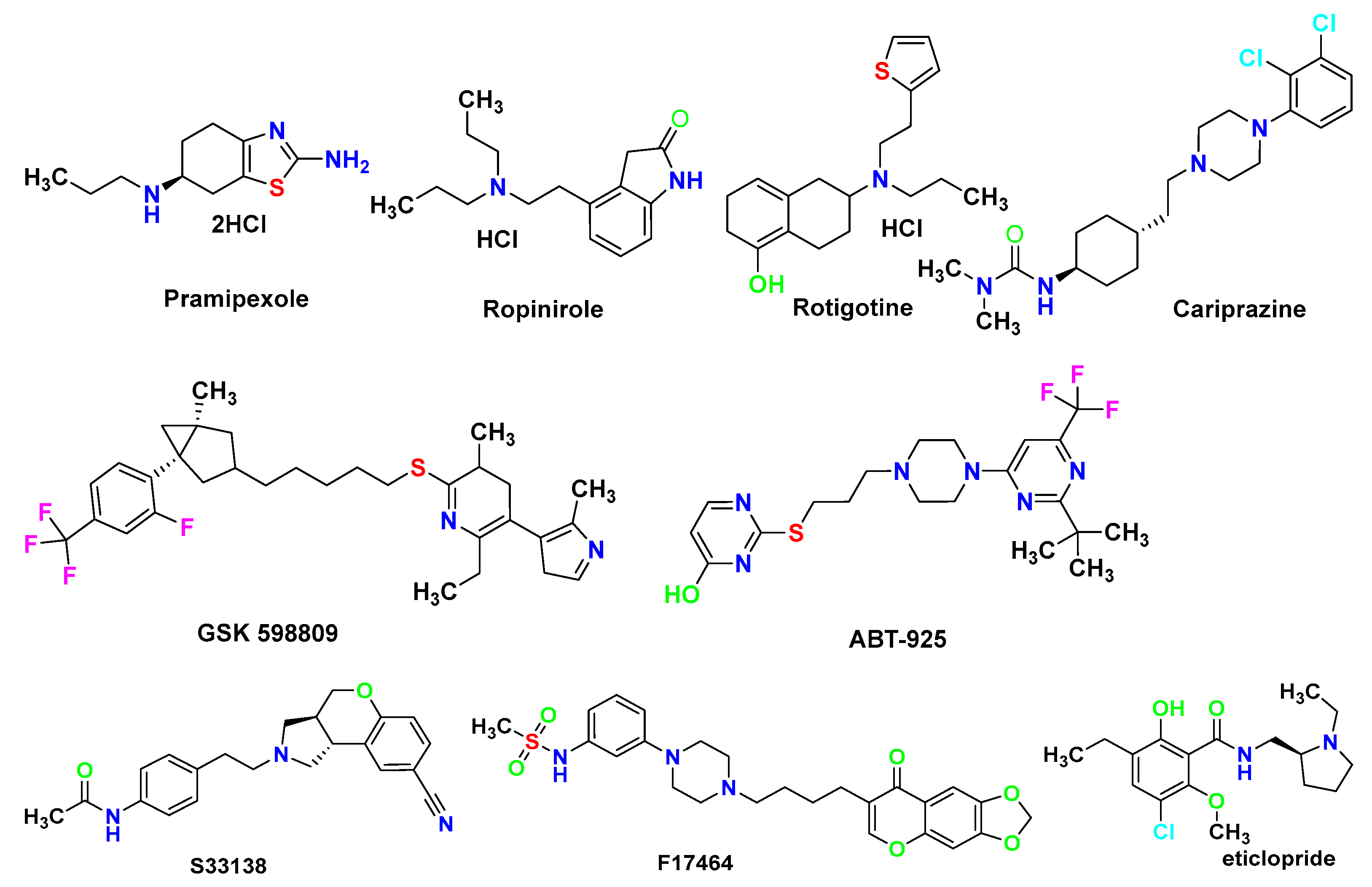

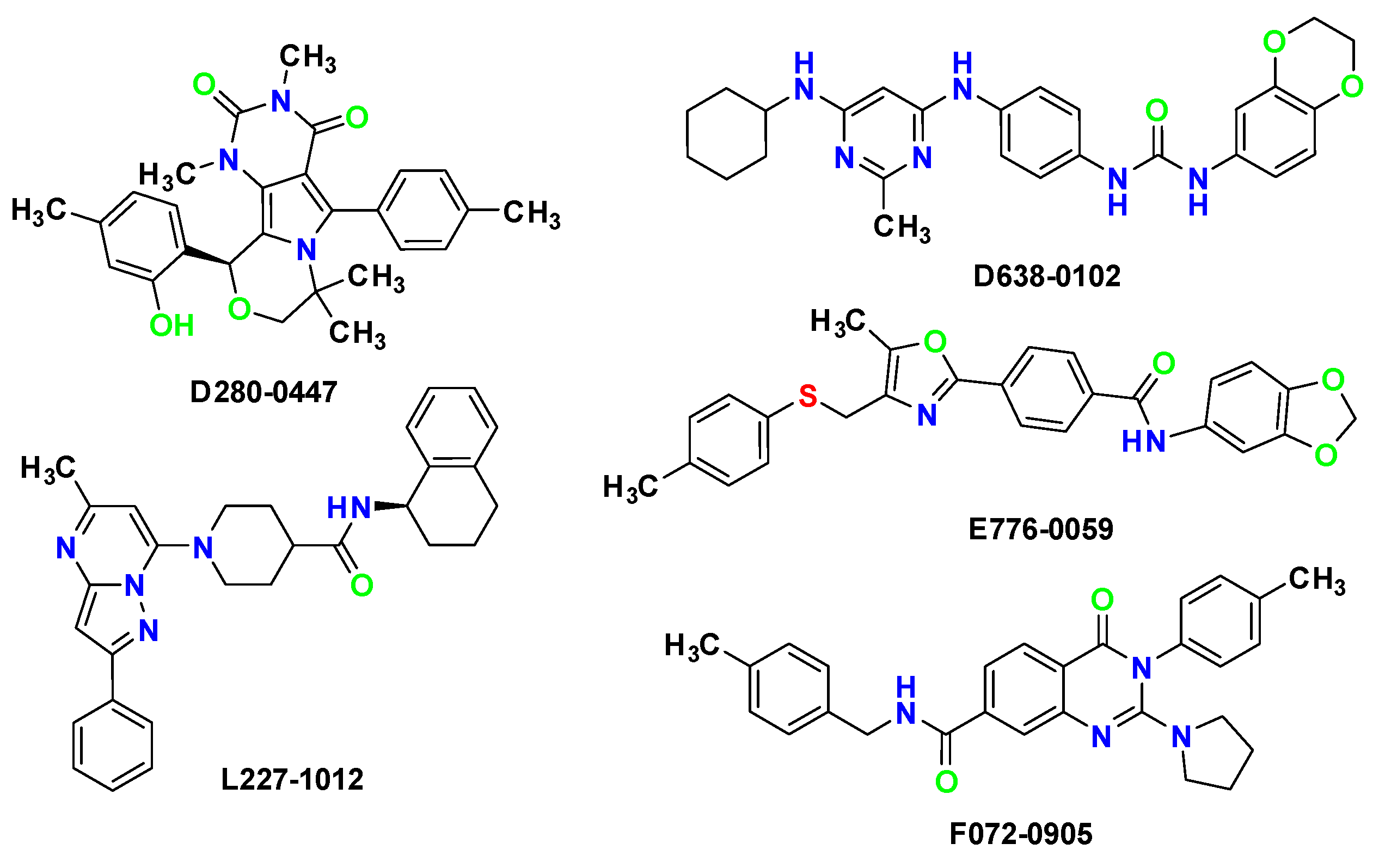
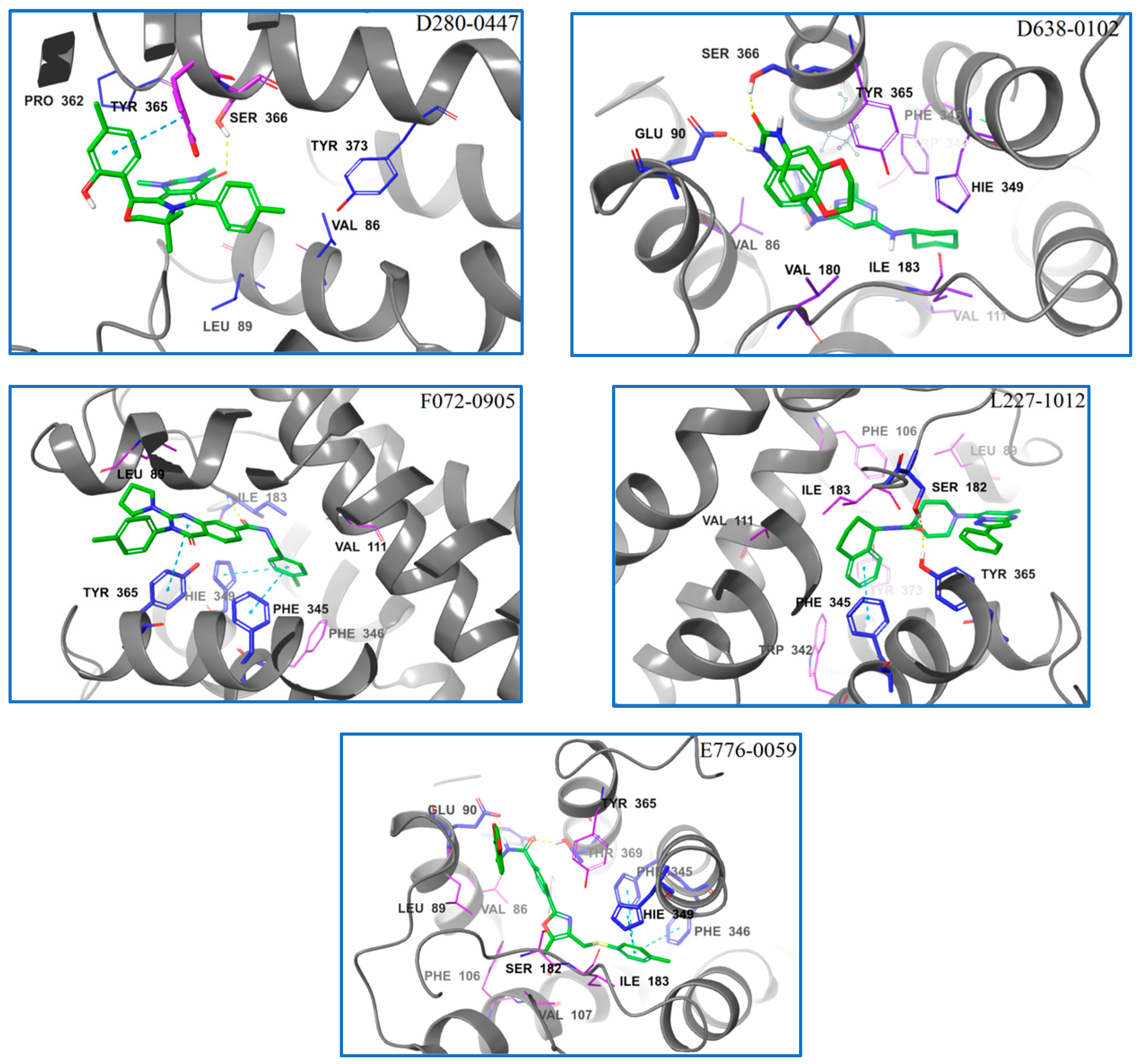
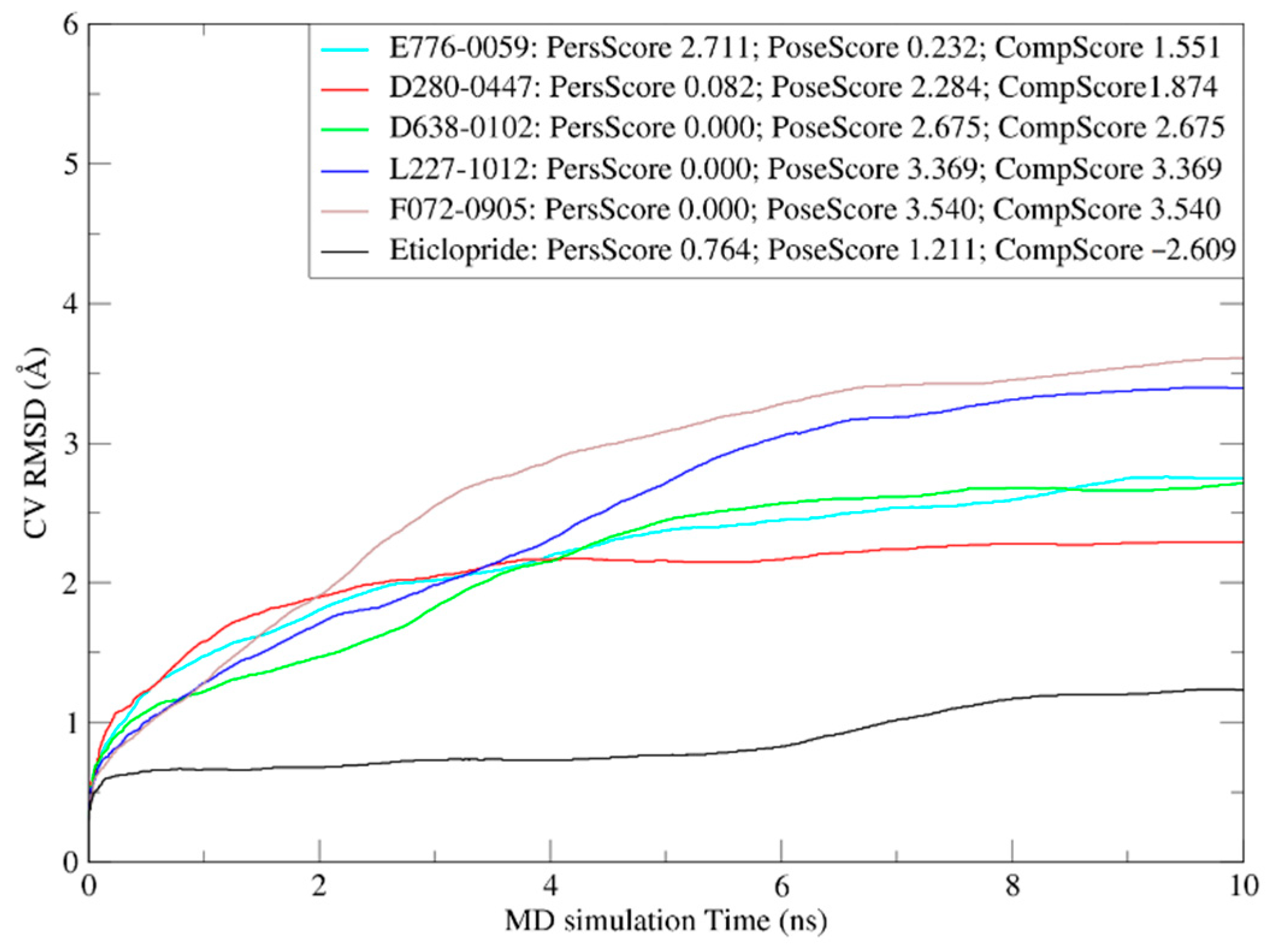
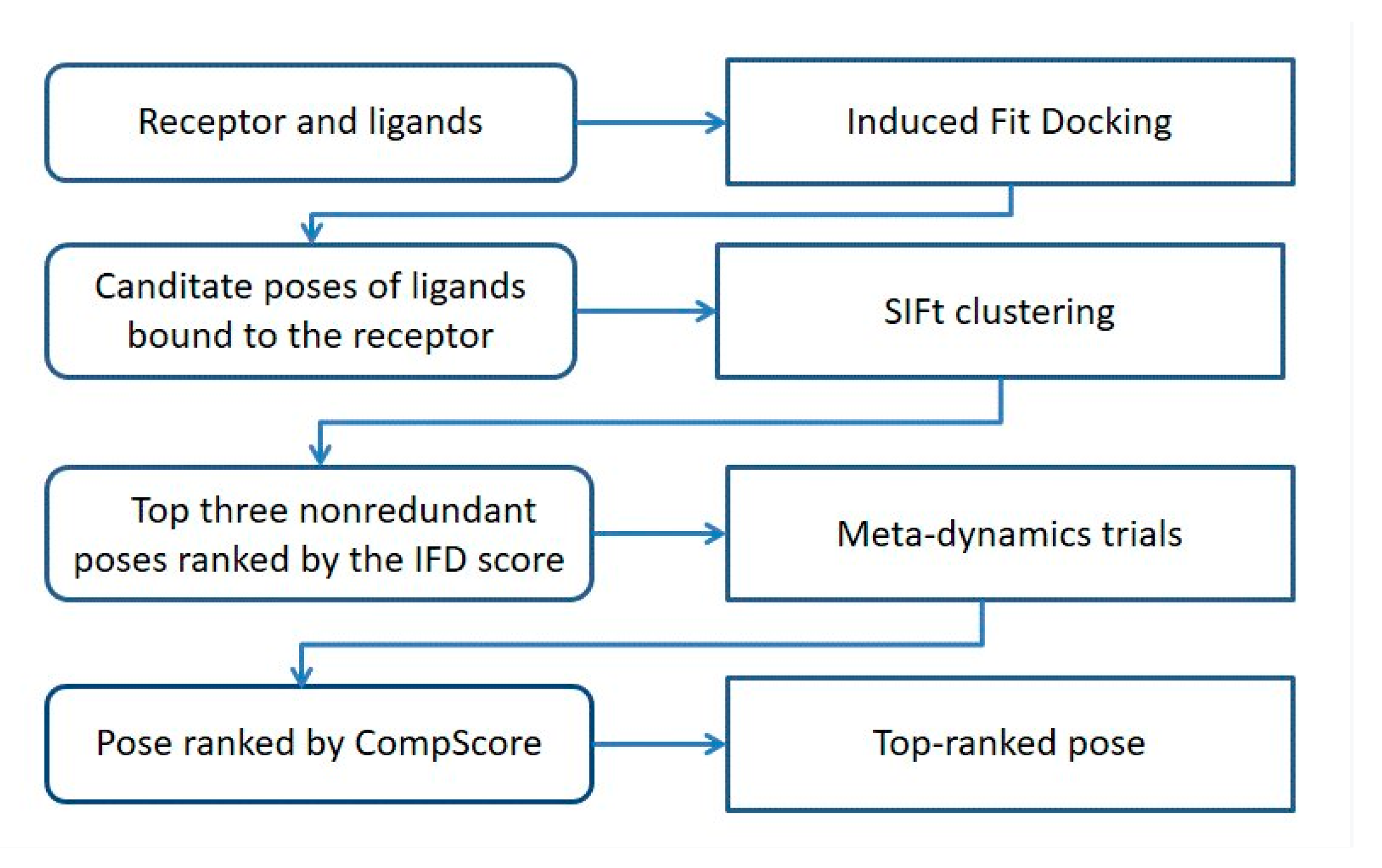




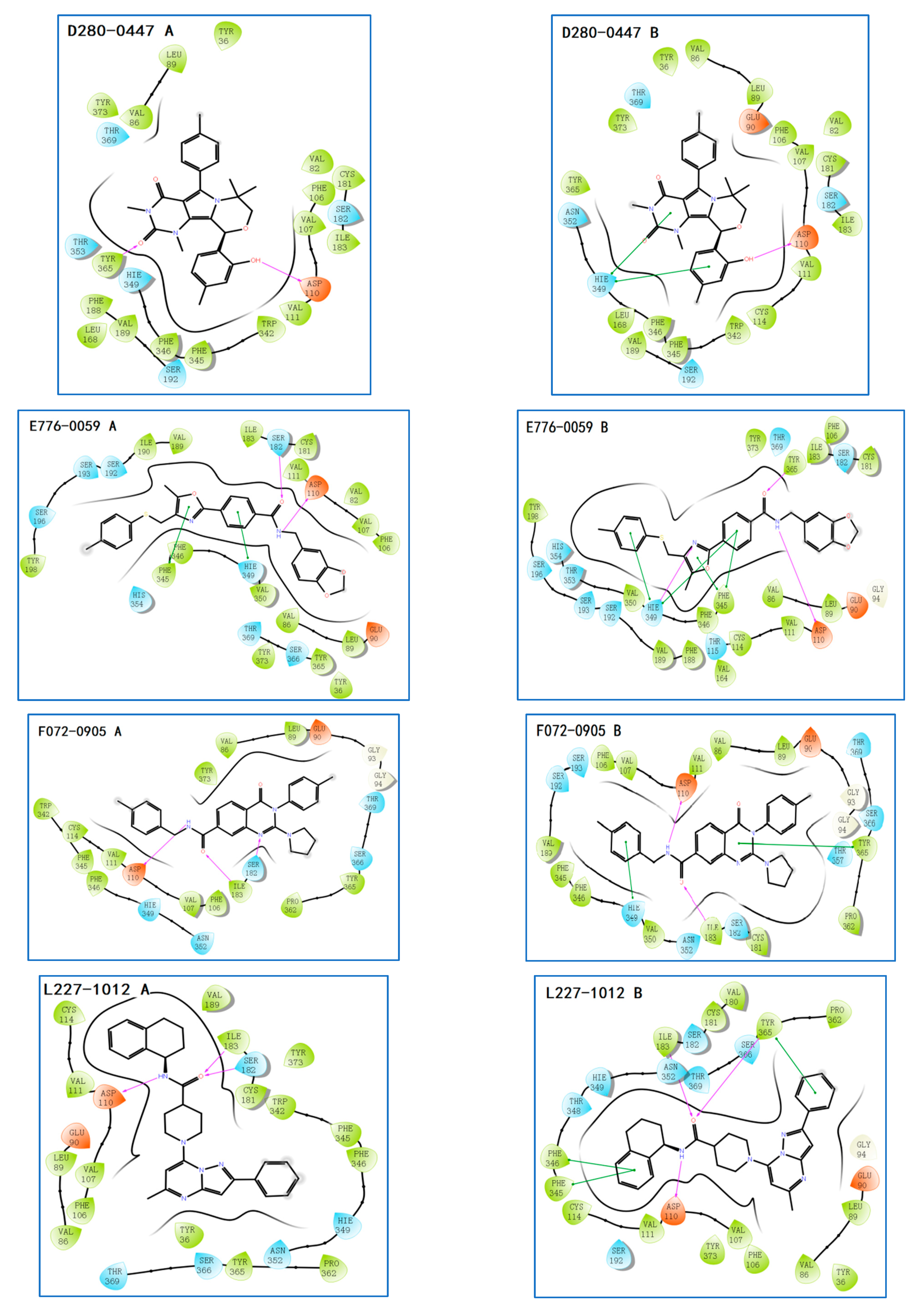

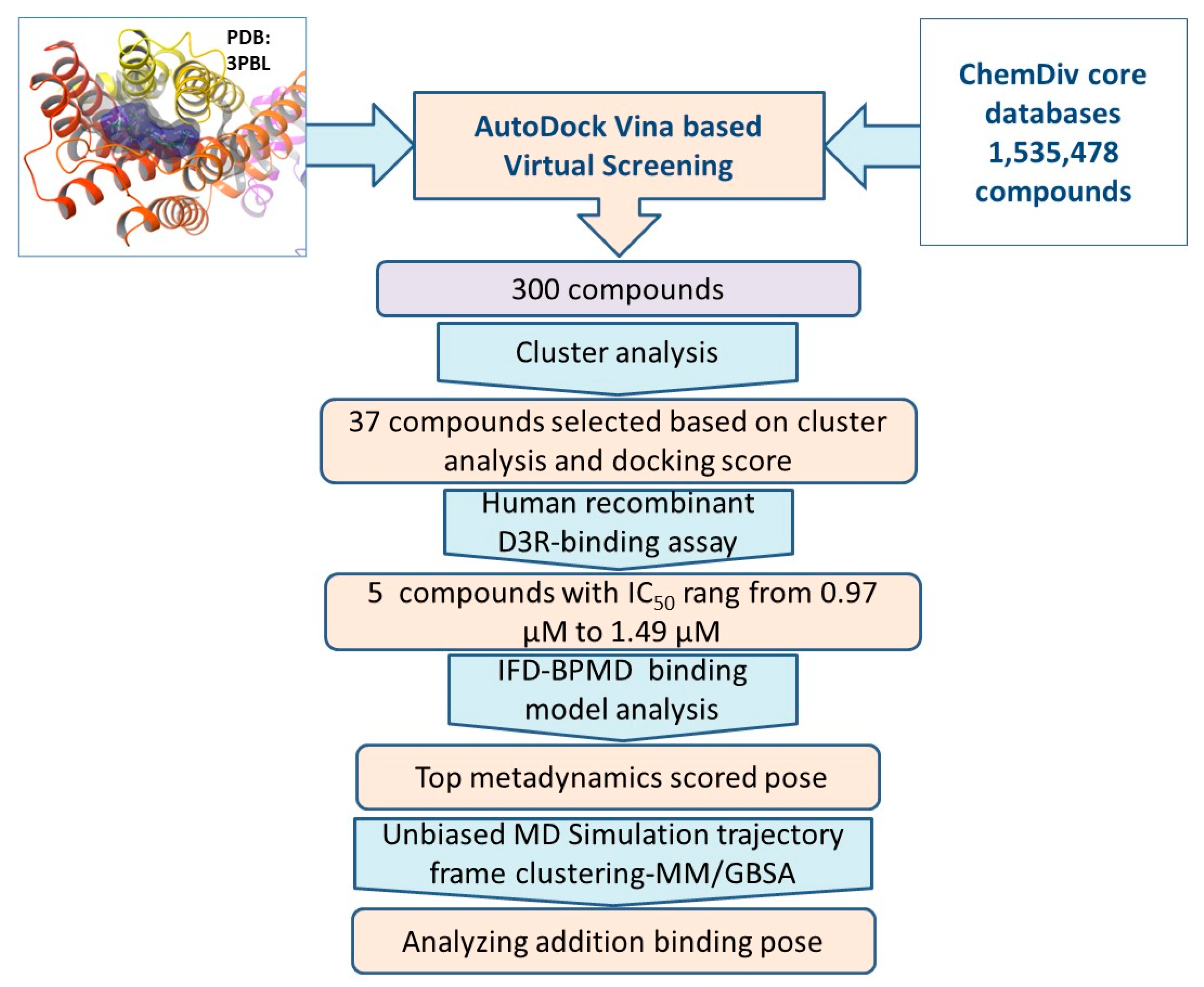
| Compound | AutoDock Vina Score (kcal/mol) | Inhibition Rate at 10 µM | IC50 (μM) | Compound | AutoDock Vina Score (kcal/mol) | Inhibition Rate at 10 µM (%) | IC50 (μM) | ||
|---|---|---|---|---|---|---|---|---|---|
| BP897 | ≥98.0% | ||||||||
| 1 | 8017-6887 | −13.0 | 74.8 | 15 | F366-0225 | −13.4 | 80.1 | 5.98 | |
| 2 | 8018-0047 | −12.4 | 79.1 | 16 | F366-0245 | −12.6 | 91.1 | 3.45 | |
| 3 | C645-0112 | −11.8 | 82.4 | 4.51 | 17 | F486-0373 | −12.0 | 71.7 | |
| 4 | C736-0093 | −12.5 | 67.8 | 18 | G373-0280 | −11.8 | 74.8 | ||
| 5 | D063-1105 | −13.3 | 78.6 | 19 | G435-0137 | −14.0 | 75.7 | ||
| 6 | D122-0034 | −13.1 | 84.1 | 4.52 | 20 | K306-0682 | −13.6 | 84.2 | 4.53 |
| 7 | D122-0078 | −12.8 | 82.3 | 4.49 | 21 | L100-0151 | −13.9 | 71.3 | |
| 8 | D638-0102 | −12.0 | 93.6 | 1.48 | 22 | L112-0768 | −13.3 | 66.4 | |
| 9 | D280-0447 | −12.2 | 99.3 | 1.25 | 23 | L153-0098 | −12.3 | 78.4 | |
| 10 | E776-0059 | −11.8 | 96.9 | 0.97 | 24 | L227-1012 | −12.5 | 94.8 | 1.49 |
| 11 | E776-1501 | −12.5 | 61.1 | 25 | L759-0276 | −13.8 | 63.4 | ||
| 12 | E859-1320 | −13.1 | 77.6 | 26 | L759-0287 | −13.2 | 89.3 | 4.11 | |
| 13 | F072-0905 | −12.4 | 99.5 | 1.41 | 27 | G544-1316 | −12.9 | 87.5 | 4.35 |
| 14 | F351-0364 | −13.5 | 71.2 |
| Compounds ID | Poses | Grouped into Clusters |
|---|---|---|
| Eticlopride | 31 | 7 |
| D638-0102 | 27 | 15 |
| D280-0447 | 8 | 4 |
| E776-0059 | 2 | 2 |
| F072-0905 | 14 | 4 |
| L227-1012 | 2 | 2 |
| Compounds ID | Pose1 | Pose2 | Pose3 | |||||||||
|---|---|---|---|---|---|---|---|---|---|---|---|---|
| IFD Score | Pose Score | Pers Score | Comp Score | IFD Score | Pose Score | Pers Score | Comp Score | Ifd Score | Pose Score | Pers Score | Comp Score | |
| Eticlopride | −474.94 | 1.008 | 0.336 | −0.672 | −474.79 | 0.944 | 0.477 | −1.441 | −474.70 | 1.894 | 0.723 | −1.721 |
| D638-0102 | −865.42 | 1.666 | 0.752 | −2.094 | −867.53 | 1.551 | 0.503 | −0.964 | −864.91 | 2.286 | 0.409 | 0.241 |
| D280-0447 | −855.76 | 1.834 | 0.364 | 0.014 | −855.46 | 1.865 | 0.241 | 0.66 | −856.59 | 1.355 | 0.00 | 1.355 |
| F072-0905 | −856.49 | 2.107 | 0.045 | 2.107 | −855.12 | 2.129 | 0.00 | 2.129 | −855.02 | 1.913 | 0.373 | 0.048 |
| L227-1012 | −867.86 | 1.835 | 0.352 | 0.758 | −867.30 | 2.117 | 0.00 | 2.117 | - | - | - | - |
| E776-0059 | −859.95 | 2.246 | 0.527 | −0.389 | −856.17 | 1.815 | 0.00 | 1.815 | - | - | - | - |
| D638-0102 | D280-0447 | L227-1012 | F072-0950 | E776-0059 | ||||||
|---|---|---|---|---|---|---|---|---|---|---|
| ① | ② | ① | ② | ① | ② | ① | ② | ① | ② | |
| Asp110 | HB(A) IB | HB(A) IB | HB(A) | HB(A) | HB(A) | HB(A) | HB(A) | HB(A) | HB(A) | HB(A) |
| Ser182 | HB(D) HB(A) | HB(D) | HB(D) | HB(D) | HB(D) | |||||
| Ile183 | HB(D) | HB(D) | HB(D) | HB(D) | ||||||
| Phe345 | π−π | π−π | π−π | 2*π−π | π−π | 2*π−π | ||||
| Phe346 | π−π | |||||||||
| Hie349 | π−π | 2*π−π | π−π | 2*π−π HB(A) | π−π | 2*π−π | ||||
| Asn352 | HB(A) | |||||||||
| Tyr365 | π−π | π−π | HB(D) | HB(D) π−π | HB(D) | HB(D) | ||||
| ΔGbind | −82.45 | −90.35 | −70.59 | −73.04 | −97.84 | −118.15 | −81.32 | −91.97 | −98.90 | −99.42 |
| RMSD | 1.50 | 0.78 | 1.60 | 2.18 | 3.33 | |||||
Disclaimer/Publisher’s Note: The statements, opinions and data contained in all publications are solely those of the individual author(s) and contributor(s) and not of MDPI and/or the editor(s). MDPI and/or the editor(s) disclaim responsibility for any injury to people or property resulting from any ideas, methods, instructions or products referred to in the content. |
© 2023 by the authors. Licensee MDPI, Basel, Switzerland. This article is an open access article distributed under the terms and conditions of the Creative Commons Attribution (CC BY) license (https://creativecommons.org/licenses/by/4.0/).
Share and Cite
Jin, H.; Wu, C.; Su, R.; Sun, T.; Li, X.; Guo, C. Identifying Dopamine D3 Receptor Ligands through Virtual Screening and Exploring the Binding Modes of Hit Compounds. Molecules 2023, 28, 527. https://doi.org/10.3390/molecules28020527
Jin H, Wu C, Su R, Sun T, Li X, Guo C. Identifying Dopamine D3 Receptor Ligands through Virtual Screening and Exploring the Binding Modes of Hit Compounds. Molecules. 2023; 28(2):527. https://doi.org/10.3390/molecules28020527
Chicago/Turabian StyleJin, Hongshan, Chengjun Wu, Rui Su, Tiemin Sun, Xingzhou Li, and Chun Guo. 2023. "Identifying Dopamine D3 Receptor Ligands through Virtual Screening and Exploring the Binding Modes of Hit Compounds" Molecules 28, no. 2: 527. https://doi.org/10.3390/molecules28020527






